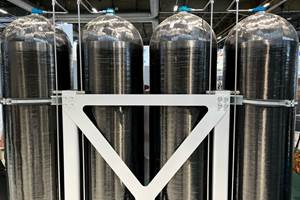Major automotive tier supplier moving to composites
A well-known Tier 1 supplier to the auto industry, Cooper Standard (Novi, MI, US) employs more than 30,000 employees at 120 facilities worldwide, and is the largest global supplier of automotive sealing systems.
A well-known Tier 1 supplier to the auto industry, Cooper Standard (Novi, MI, US) employs more than 30,000 employees at 120 facilities worldwide, and is the largest global supplier of automotive sealing systems. It also produces fuel and brake systems, fluid transfer systems and anti-vibration systems (AVS). And the big news is that in the AVS category, Cooper Standard is undergoing a significant materials shift from well-established, legacy metals to composites.
“These are big, sturdy traditional parts that have been made for more than half a century,” notes Joe Emmi, Cooper Standard VP and managing director global AVS, referring to AVS body, strut and engine mounts typically formed from cast aluminum, stamped steel and rubber. “Our corporate mission is to innovate and provide superior products,” he points out, “and thanks to advances in material science and design, the composite parts we’ve developed can now pass all of our tests.”
He calls out three factors that have motivated Cooper Standard’s move to fiber-reinforced plastics:
1) A growing demand from consumers for more comfort (in this case, less vibration) in both cars and trucks.
2)A need to reduce weight for OEMs for both better fuel economy and to accommodate more amenities.
3)A growing acceptance from OEM customers for new structural composite part designs, if they can meet performance criteria.
The criteria are substantial for these structural parts. For example, Emmi explains that body mounts, which attach a passenger vehicle’s body to the structural frame, come in two types: conventional steel and rubber mounts and hydraulically damped mounts. The hydraulic mounts conduct fluid between two internal chambers to develop damping and improve the ride response of the vehicle. These mounts have typically been developed using stamped steel or cast aluminum housings, but they have now been replaced with composite plastics: “We converted one of our hydro mounts, originally a rubber sleeve inside a steel housing, to a glass-reinforced nylon composite.” He points out that in addition to saving significant weight, the composite housing meets customer performance requirements. “These are critical parts that must secure the body firmly to the frame,” he adds. “Our customer understandably was a bit worried about the composite design, but we have demonstrated that it works.”
Another example in composites, also developed under Cooper Standards’ DynaFib Innovation Program, was conducted in partnership with a university and a composite materials supplier for a European OEM. In this case, says Emmi, “the strategic effort was aimed at advancing the process as well as the material and part design.” DynaFib sought to extend the applicability of plastic bracketry by providing increased tensile strength at a significant mass savings. The group worked with Coriolis Composites (Queven, France) on an automated process that loops a continuous glass/thermoplastic fiber over two torque isolation mounts, with the continuous fiber designed to handle peak engine torque loads. The loop and mounts are then overmolded with polyamide. Emmi explains that the composite torque strut mount, designed to work within an engine mount system, weighs 50% less than the legacy aluminum part, and offers better tensile strength than a metallic solution. We’re targeting introduction on a 2019 model year vehicle.” He adds, “We’re replacing metals with composites in our AVS business in parts that require high tensile strength, like brackets, torsional displacement arms and strut mounts.”
Related Content
Recycling hydrogen tanks to produce automotive structural components
Voith Composites and partners develop recycling solutions for hydrogen storage tanks and manufacturing methods to produce automotive parts from the recycled materials.
Read MoreCo-molding SMC with braided glass fiber demonstrates truck bed potential
Prepreg co-molding compound by IDI Composites International and A&P Technology enables new geometries and levels of strength and resiliency for automotive, mobility.
Read MoreSMC composites progress BinC solar electric vehicles
In an interview with one of Aptera’s co-founders, CW sheds light on the inspiration behind the crowd-funded solar electric vehicle, its body in carbon (BinC) and how composite materials are playing a role in its design.
Read MoreInfinite Composites: Type V tanks for space, hydrogen, automotive and more
After a decade of proving its linerless, weight-saving composite tanks with NASA and more than 30 aerospace companies, this CryoSphere pioneer is scaling for growth in commercial space and sustainable transportation on Earth.
Read MoreRead Next
VIDEO: High-volume processing for fiberglass components
Cannon Ergos, a company specializing in high-ton presses and equipment for composites fabrication and plastics processing, displayed automotive and industrial components at CAMX 2024.
Read More“Structured air” TPS safeguards composite structures
Powered by an 85% air/15% pure polyimide aerogel, Blueshift’s novel material system protects structures during transient thermal events from -200°C to beyond 2400°C for rockets, battery boxes and more.
Read MoreDeveloping bonded composite repair for ships, offshore units
Bureau Veritas and industry partners issue guidelines and pave the way for certification via StrengthBond Offshore project.
Read More

























